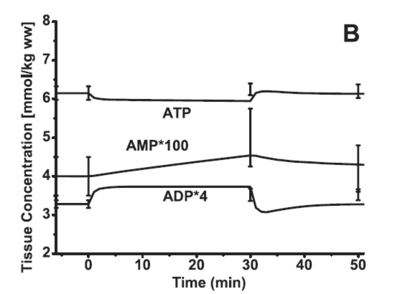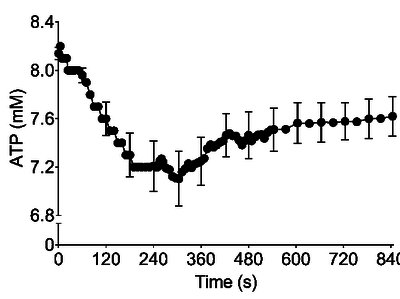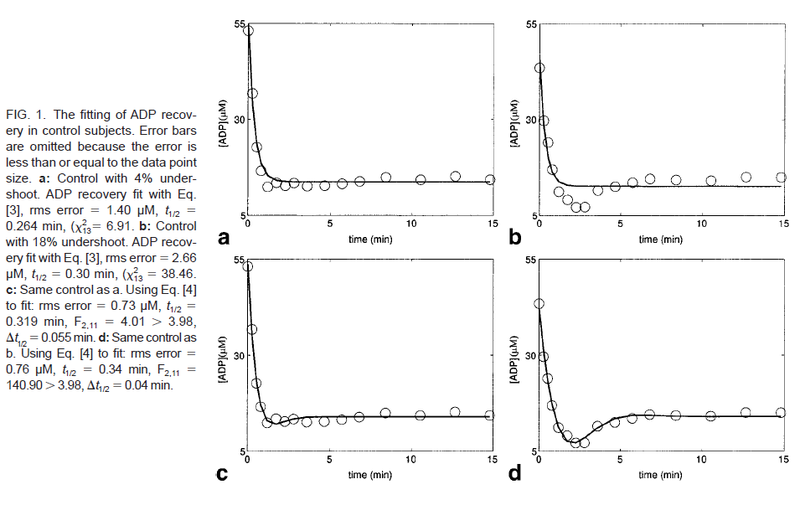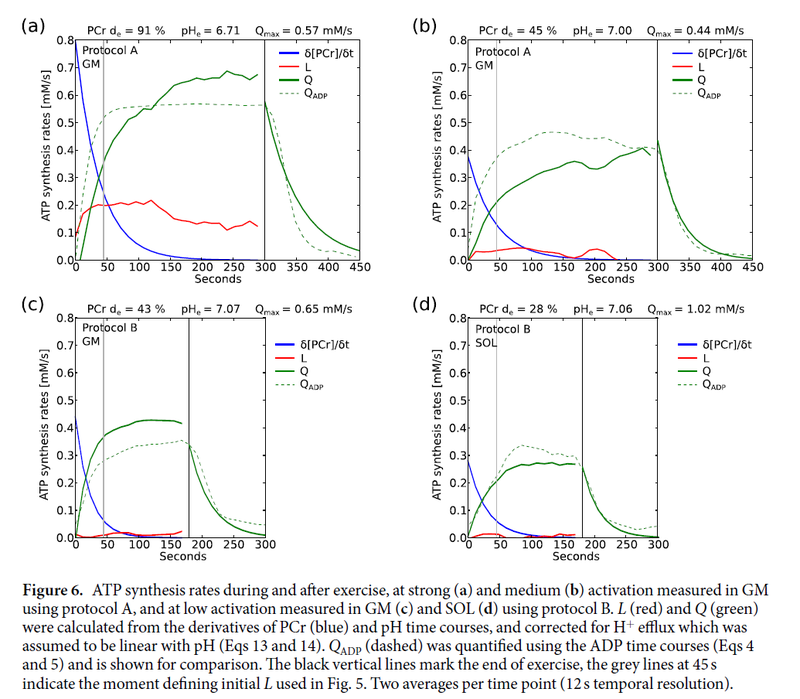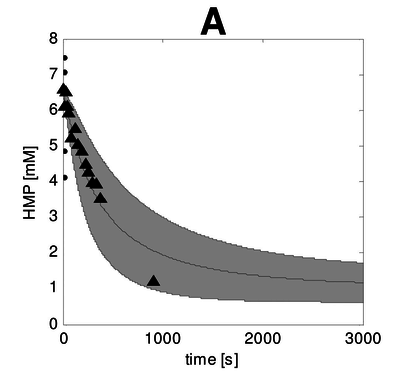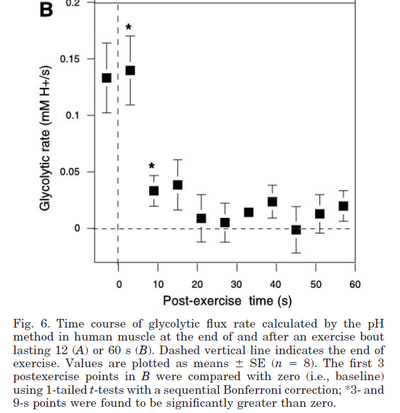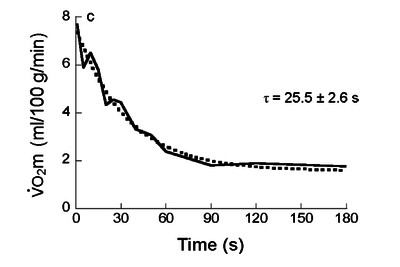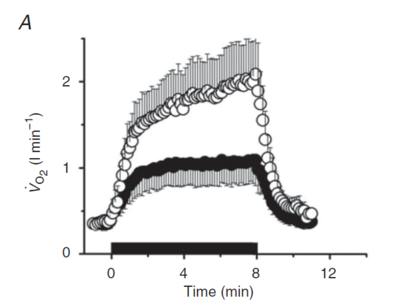Dynamics of deactivation
For model validation, recovery dynamics, ATP, ADP, AMP, PCr, glycolysis, oxidative phosphorylation Ver. 1.0.
Contents
Recovery dynamics: ATP, ADP, AMP, PCr
Figure from (Li et al., 2009) [1], Recovery dynamics for ATP, ADP, AMP (model)
Figure from (Coccimiglio et al., 2020) [2], Recovery dynamics for PCr, ATP, ADP, AMP (model)
Figure from (Bartlett et al., 2020) [3], Changes in intramuscular ATP during the 240 s trial and 10 minutes of recovery. A slow ATP recovery rate is probably caused by a decrease in the total pool of adenine nucleotides associated with the formation of IMP and the excretion of its metabolites, see (Sahlin & Broberg, 1990) [4].
Figure from (Chen et al., 1999) [5], Recovery dynamics for cytosolic ADP after exercise.
Figure from (Fiedler et al., 2016) [6], Recovery dynamics for PCr and pH after exercise at 40% maximum voluntary contraction (MVC)
Figure from (Fiedler et al., 2016) [6], Recovery dynamics for ADP and ATP synthesis rates during and after exercise at 40% maximum voluntary contraction (MVC)
Table from (Hellsten et al., 1999) [7], Skeletal muscle concentrations of adenine nucleotides. AMP is decreased at the end of the exercise compared to rest, while AMP free is increased. At the same time, IMP rises, perhaps that is why AMP decreases (?)
Dynamics of glycolysis after cessation of exercise
Figure from (Schmitz et al., 2010) [8], HMP recovery dynamics. “First, we performed high time resolution dynamic in vivo measurements of the turnover of phosphorylated glycolytic metabolites (hexose monophosphates; HMP) in human leg muscle after exhaustive exercise using 31P NMR spectroscopy. Next, the Lambeth & Kushmerick computational model of glycolysis in muscle was used as a platform to investigate if current knowledge of glycolytic flux and concentration control incorporated in the model was sufficient to explain the measured HMP dynamics (Lambeth & Kushmerick, 2002)”.
Figure from (Crowther et al., 2002) [9], Time course of glycolytic flux rate in human muscle at the end of and after an exercise bout.
Dynamics of muscle VO2 recovery after cessation of exercise
Figure from (Behnke et al., 2009) [10], The time course of muscle VO2 recovery from contractions (i.e., muscle VO2 off-kinetics).
Figure from (Cannon et al., 2014) [11], The time course of muscle VO2 during and after cessation of exercise.
References
- Li Y, Dash RK, Kim J, Saidel GM, and Cabrera ME. Role of NADH/NAD+ transport activity and glycogen store on skeletal muscle energy metabolism during exercise: in silico studies. Am J Physiol Cell Physiol. 2009 Jan;296(1):C25-46. DOI:10.1152/ajpcell.00094.2008 |
- Coccimiglio IF and Clarke DC. ADP is the dominant controller of AMP-activated protein kinase activity dynamics in skeletal muscle during exercise. PLoS Comput Biol. 2020 Jul;16(7):e1008079. DOI:10.1371/journal.pcbi.1008079 |
- Bartlett MF, Fitzgerald LF, Nagarajan R, Hiroi Y, and Kent JA. Oxidative ATP synthesis in human quadriceps declines during 4 minutes of maximal contractions. J Physiol. 2020 May;598(10):1847-1863. DOI:10.1113/JP279339 |
- Sahlin K and Broberg S. Adenine nucleotide depletion in human muscle during exercise: causality and significance of AMP deamination. Int J Sports Med. 1990 May;11 Suppl 2:S62-7. DOI:10.1055/s-2007-1024856 |
- Chen JT, Argov Z, Kearney RE, and Arnold DL. Fitting cytosolic ADP recovery after exercise with a step response function. Magn Reson Med. 1999 May;41(5):926-32. DOI:10.1002/(sici)1522-2594(199905)41:5<926::aid-mrm11>3.0.co;2-1 |
- Fiedler GB, Schmid AI, Goluch S, Schewzow K, Laistler E, Niess F, Unger E, Wolzt M, Mirzahosseini A, Kemp GJ, Moser E, and Meyerspeer M. Skeletal muscle ATP synthesis and cellular H(+) handling measured by localized (31)P-MRS during exercise and recovery. Sci Rep. 2016 Aug 26;6:32037. DOI:10.1038/srep32037 |
- Hellsten Y, Richter EA, Kiens B, and Bangsbo J. AMP deamination and purine exchange in human skeletal muscle during and after intense exercise. J Physiol. 1999 Nov 1;520 Pt 3(Pt 3):909-20. DOI:10.1111/j.1469-7793.1999.00909.x |
- Schmitz JP, van Riel NA, Nicolay K, Hilbers PA, and Jeneson JA. Silencing of glycolysis in muscle: experimental observation and numerical analysis. Exp Physiol. 2010 Feb;95(2):380-97. DOI:10.1113/expphysiol.2009.049841 |
- Crowther GJ, Kemper WF, Carey MF, and Conley KE. Control of glycolysis in contracting skeletal muscle. II. Turning it off. Am J Physiol Endocrinol Metab. 2002 Jan;282(1):E74-9. DOI:10.1152/ajpendo.2002.282.1.E74 |
- Behnke BJ, Ferreira LF, McDonough PJ, Musch TI, and Poole DC. Recovery dynamics of skeletal muscle oxygen uptake during the exercise off-transient. Respir Physiol Neurobiol. 2009 Sep 30;168(3):254-60. DOI:10.1016/j.resp.2009.07.013 |
- Schmitz JP, Groenendaal W, Wessels B, Wiseman RW, Hilbers PA, Nicolay K, Prompers JJ, Jeneson JA, and van Riel NA. Combined in vivo and in silico investigations of activation of glycolysis in contracting skeletal muscle. Am J Physiol Cell Physiol. 2013 Jan 15;304(2):C180-93. DOI:10.1152/ajpcell.00101.2012 |
